Intel’s Sandy Bridge i7-2820QM: Upheaval in the Mobile Landscape
by Jarred Walton on January 3, 2011 12:00 AM EST- Posted in
- Laptops
- Intel
- Sandy Bridge
- Compal
Mobile Sandy Bridge Gaming Performance
Sandy Bridge is clearly a faster CPU than the preceding Arrandale and Clarksfield offerings—that’s no surprise. The integrated graphics are also faster, but being faster than old Intel’s HD Graphics isn’t saying a whole lot. Then again, AMD’s old HD 4250 IGP isn’t much better and is long overdue for a replacement. We’ll talk about that in a second, but first here are the standard gaming performance results at our “Low” defaults. “Medium” detail will be on the next page.
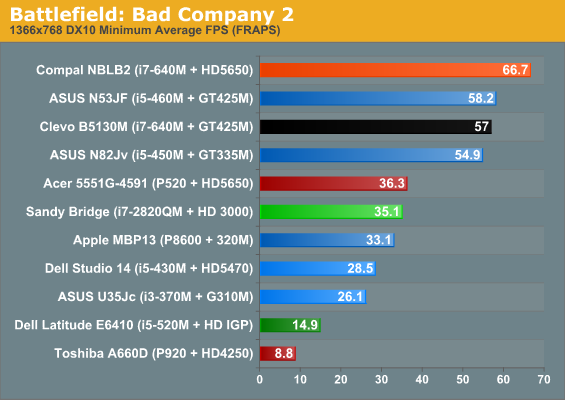
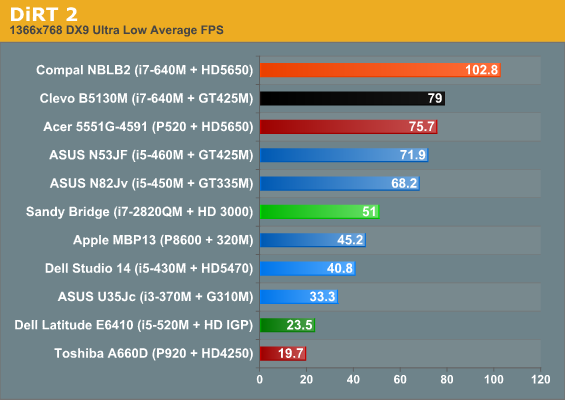

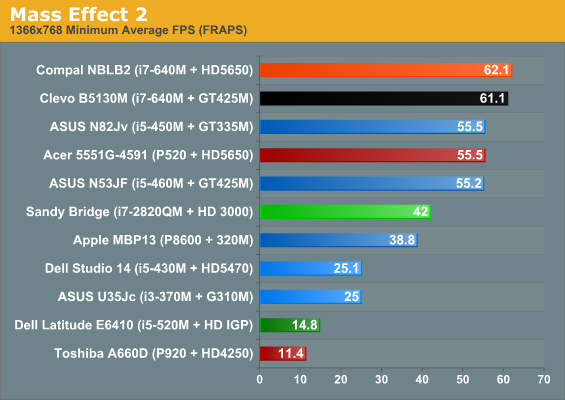
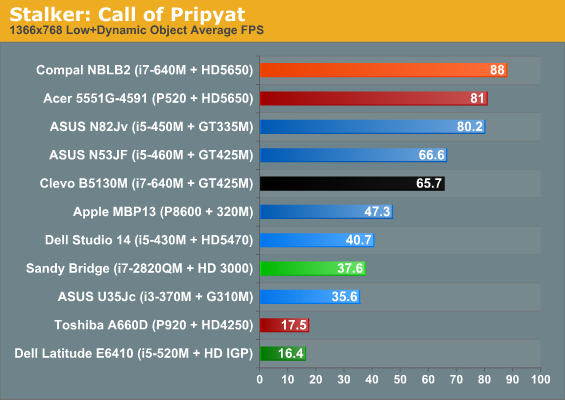
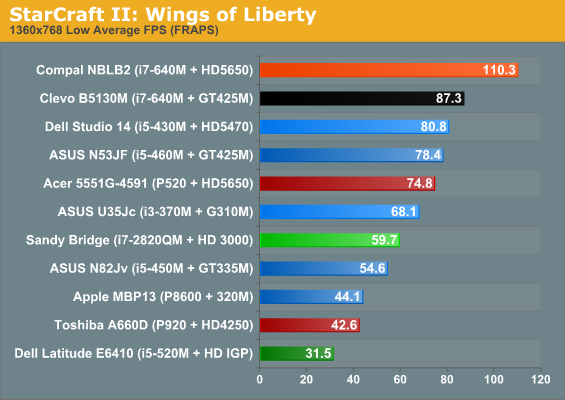
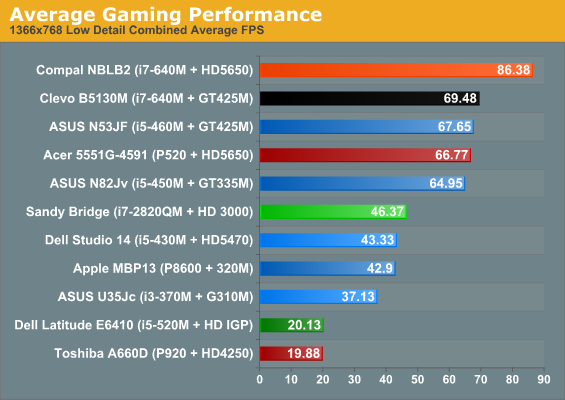
Let’s start by talking about compatibility problems with the Intel IGP: there were none! I know it’s been fashionable over the years to bash on Intel for horrible drivers that can’t run games, and the previous IGPs certainly still fall into that “too slow” category, but of our standard six test titles both Sandy Bridge and Arrandale IGPs loaded and ran every single title. That makes talk of performance meaningful, and that’s the bigger story by far.
Again, Sandy Bridge delivers playable performance in every single title at 768p and “Low” detail settings. What’s more, it actually surpasses the GeForce 320M in Apple’s MacBook Pro 13 in five out of six games (the exception being STALKER). Similarly, it beats the entry-level Radeon Mobility 5470 in four out of six games (STALKER and StarCraft II being the exceptions) and the G 310M in five out of six (SC2 came out ahead on the 310M).
All told, Intel’s HD Graphics 3000 checks in an average of 6% faster than HD 5470, 8% faster than GeForce 320M, 25% faster than G 310M, and a whopping 130% faster than both the previous generation HD Graphics and AMD’s HD 4250 (which are essentially tied in overall performance across the selected titles). Which is not to say it wins everywhere; even with a much slower Turion II P520 Processor, the HD 5650 still leads HD 3000 by 44%; shift the same GPU to an i7-640M to remove the CPU bottleneck and the 5650 beats HD 3000 by 130%. NVIDIA’s GeForce GT 425M also leads the 3000 by 46% on average, so discrete GPUs are by no means in danger of being replaced.
We didn't have time to do serious image quality comparisons, but subjectively there did appear to be a few games where the Intel IGP wasn't rendering at the same level of detail, but it's hard to say when you're not running at the native LCD resolution; we'll get into problems in a moment, but other than those mentioned we didn't have any serious complaints. After all, being able to run a game at all is the first consideration; making it look good is merely the icing on the cake.










66 Comments
View All Comments
tipoo - Monday, January 3, 2011 - link
Sorry if I missed this somewhere in the review, but does the graphics component support OpenCL?RyuDeshi - Monday, January 3, 2011 - link
Second to last paragraph on the "Extended compatibility and performance results:""Ultimately, Sandy Bridge’s IGP is far more capable than many would have expected. Sure, it doesn’t even try to support DX11 or OpenCL, but at least for gaming DX11 is typically too much for even midrange GPUs."
CharonPDX - Monday, January 3, 2011 - link
An Intel rep has said that Sandy Bridge will support OpenCL. (http://news.cnet.com/8301-13924_3-20024079-64.html ) The trick is that it may be a combo CPU+GPU to do it. So it may not be what you are thinking by OpenCL being solely GPU, but OpenCL code should be able to run.And in the end, what does it matter, really, as long as it runs? As the desktop Sandy Bridge review points out, video encoding is just as fast using solely the x86 codepaths as using nVidia's CUDA or ATI's Stream.
Voldenuit - Monday, January 3, 2011 - link
OpenCL was designed from the outset to run on heterogenous resources, including CPU.So intel claiming that they "support" OpenCL is nothing special - they just needed the right drivers/API.
However, don't expect OpenCL code running solely on the CPU (my guess as to how SB will handle it) to be any faster than the x86 codepath running on the same CPU.
Checkbox feature.
jameskatt - Monday, January 3, 2011 - link
What Intel wants to do is to have the CPU run OpenCL code.This totally defeats the purpose of OpenCL.
OpenCL is suppose to allow both the GPU and the CPU to run code simultaneously. This is to allow significant acceleration in running OpenCL code compared to using just the CPU.
Sure. OpenCL code will run. But it will run MORE SLOWLY than with a discrete GPU. And the 16 GPUs in Sandy Bridge will be wasted.
Intel's Sandy Bridge has non-programmable GPUs. This is a serious limitation and deal killer when it comes to running OpenCL code.
I expect Apple to continue use nVidia's or AMD's discrete GPUs with the MacBooks and Mac Book Pros.
This is very disappointing. It shows that Intel still doesn't have the talent to produce decent GPUs.
PlasmaBomb - Monday, January 3, 2011 - link
*cough* I think you mean 12 EU *cough*
Guspaz - Monday, January 3, 2011 - link
<i>What Intel wants to do is to have the CPU run OpenCL code.This totally defeats the purpose of OpenCL.
OpenCL is suppose to allow both the GPU and the CPU to run code simultaneously. This is to allow significant acceleration in running OpenCL code compared to using just the CPU.</i>
No, this is the *primary* purpose of OpenCL. The goal of OpenCL is not to "allow the GPU and CPU to run code simultaneously", but to provide a single unified code path that can be used with any hardware, be it CPU or GPU. There are/were already code paths specific to each vendor/type (CUDA for nVIDIA GPUs, Stream for AMD/ATI GPUs, x86 for Intel/AMD CPUs). The problem is that fully supporting all three platforms requires three separate code paths.
OpenCL unifies this, and allows a single codepath to be used regardless of the GPU's type or existence. You've completely misunderstood the purpose of OpenCL.
Wiggy McShades - Tuesday, January 4, 2011 - link
You need to ask what applications on a desktop actually use OpenCL in a meaningful way? Intel added hardware for media transcoding, which makes transcoding on something besides the cpu useless and that was roughly all openCL can be used for on the desktop, laptop, or cellphone.OpenCL is for vector calculations, AVX is for vector calculations. All four cores running AVX instructions would just be a faster choice than OpenCL on a low end gpu. Intel most likely could get sandybridge's gpu running OpenCL, but it would be pointless. OpenCL just is not a desktop feature.
strikeback03 - Wednesday, January 5, 2011 - link
Given how much money they have, I doubt Intel is lacking the "talent" to do anything they want. OpenCL execution on the GPU portion of the SNB chips was probably just not that big a deal to them, and given the number of other things (such as speed and battery life) SNB brings to the table they probably won't have trouble selling lots of these to the average consumer.8steve8 - Monday, January 3, 2011 - link
which mobile cpus on pg1 support TXT or VT-d or AES-NI or VT-x or Quick Sync?